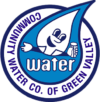Community Water Company of Green Valley (“Community Water”) is committed to maintaining the safety and quality of the water supply that complies with EPA regulations.
We are conducting a comprehensive survey of service lines to identify any that may pose a risk due to the presence of lead. To date, Community Water’s survey of over 1,000 service lines has not identified any lead service lines in our water system. We have approximately 4,000 service lines remaining to be verified visually before October 2027.
The pipe that connects your home or business to the main water line (referred to as a service line) is currently listed as unknown, which means it may contain lead or be a galvanized pipe that was once connected to a lead line. Homes with lead or galvanized service lines previously connected to lead can pose an increased risk of lead exposure through drinking water. For this reason, it is essential to identify and address potential risks to ensure continued water safety.
For information on sources of lead that include service lines and interior plumbing, please visit https://www.epa.gov/ground-water-and-drinking-water/basic-information-about-lead-drinking-water#getinto.
Please share this information with anyone who drinks and cooks using water at this property.
Identifying service line material
EPA has developed an online step-by-step guide to help people identify lead pipes in their homes called Protect Your Tap: A Quick Check for Lead. Please visit https://www.epa.gov/ground-water-and-drinking-water/protect-your-tap-quick-check-lead
HEALTH EFFECTS OF LEAD
Exposure to lead in drinking water can cause serious health effects in all age groups. Infants and children can have decreases in IQ and attention span. Lead exposure can lead to new learning and behavior problems or worsen existing learning and behavior problems. The children of women who are exposed to lead before or during pregnancy can have an increased risk of these negative health effects. Adults can have increased risks of heart disease, high blood pressure, kidney, or nervous system problems.
Steps you can take to reduce lead in drinking water.
Below are recommendations by the EPA for actions that you may take, separately or in combination, if you are concerned about lead in your drinking water. The list also includes where you may find more information and is not intended to be a complete list or to imply that all actions equally reduce lead in drinking water.
- Use filters properly. Certain filters can reduce lead in drinking water, and they should be certified to remove lead. Read the directions provided with the filter to learn how to properly install, maintain, and use your cartridge and when to replace it. For more information on home water filtration systems, please visit
- Clean your aerator. Regularly clean your faucet’s aerator (the small screen at the end of your faucet) to remove any sediment, debris, or lead particles that may have been collected.
- Use cold water. Use cold water for drinking, cooking, and preparing baby formula. Lead dissolves more easily in hot water, and boiling does not remove it from the water.
- Run your water. Let your water run before using it for drinking or cooking if it has been sitting in the pipes for a while, as this can increase lead levels. Running the tap, taking a shower, or starting a load of laundry or dishes can help flush out stagnant water.
- Get your child tested to determine lead levels in their blood. Although there is no confirmation of having a lead service line, you may wish to speak with a healthcare provider to see if your child’s blood lead level is elevated or if you are concerned about potential exposure. For information on these actions, please visit http://www.cdc.gov/lead-prevention/hcp/clinical-guidance/index.html
- Learn what your service line material is. Community Water maintains records of the materials used on the Community Water side of the meter, and to date, no lead pipes have been identified. Customers are responsible for the service line installed beyond the meter. To comply with EPA regulations, the Community Water Company is required to conduct an inventory of observable materials on the customer’s side of the meter; this process will take time to complete. Customers can hire a licensed plumber at their own expense to independently determine the material of the pipe connecting the Company’s meter to the home. While Community Water does not recommend specific plumbers, you can contact the Green Valley Sahuarita Chamber of Commerce at 520-625-7575 for a list of local professionals.
- Have your water tested. Community Water routinely tests for lead and copper in the water; to date, no samples exceed the allowable limits. Community Water does not endorse specific third-party vendors; you have the option to test your water independently at your own expense.
For certified laboratories, please visit the Arizona Department of Health Services website
https://ells-lab-search.azdhs.gov/ArizonaCertifiedLabs/LabSearchContentPage.
For more information on reducing lead exposure from your drinking water and the health effects of lead, visit EPA’s website at https://www.epa.gov/lead. Note: You are receiving this notice because we have not yet confirmed the material composition of the service line that connects your property to the main water system. While no action is required, the information enclosed may be helpful. Community Water’s Annual Water Quality Report is available on our website, www.communitywater.com.
